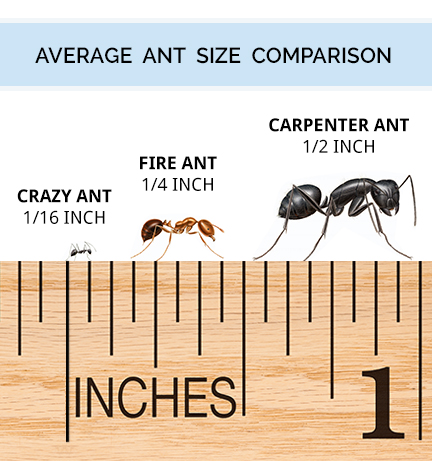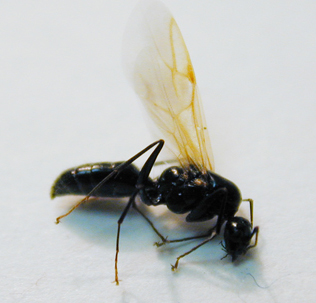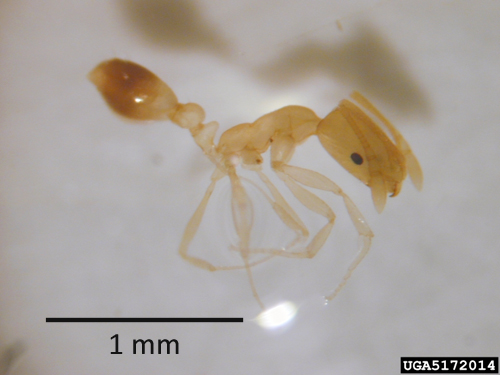Identify Ants
Ants can be a challenge to identify without the proper equipment and experience. In many cases, the best way to confirm the identity of an ant is to enlist the help of a pest management professional. Nevertheless, it is possible to identify some of the most common species of household ants without a microscope.
The following pictures and descriptions can be used to help you identify some of the most common Texas ant species. Once you know the species of ant in your home, you can determine where it is likely to nest, what kind of damage it causes, and what kind of control measures are most effective.
Characters used to identify ants
Before you can identify an ant, you should familiarize yourself with a few key things to look for. Before, or while, you collect an ant to identify, look around the area for other similar ants. All ants live in colonies and rarely travel alone. They can usually be seen hunting as a colony for food along well-established foraging trails. When you see an ant trail, observe whether the different workers on the trail vary in size, or whether they are all identical in size. If you can follow the ant trail back to the nest, observe the nest itself. Also, take note of when the ants are active–are they active mostly during the day, or are they most active at night.
If you are still unsure of the ant species after observing them in action, collect a few to examine under a hand lens, magnifier, or microscope, if you have one. The easiest way to capture and kill ants for examination is to fill a small vial, pill container, or jar with a small amount of ethanol or rubbing alcohol. Use the end of a soft cloth, or a brush, wet with alcohol to pick up the ants and drop them in your container. The alcohol will kill your ants quickly and allow you to examine them more closely.
Body characters
Ants, like all insects, have three main body regions. Unlike many other insects, however, ant body regions are very distinct, with obvious constrictions between the head and thorax, and thorax and abdomen (or gaster)(see drawing). Most ants also have antennae with a long first segment that creates a bend, or “elbow” in the middle of the antennae. Although worker ants, the most abundant members of the ant colony, are wingless, the reproductive caste in the ant colony may have wings. One or more times a year, these reproductive ants may fly from the nest (swarming) as part of the mating process. Termites, also social insects, also swarm periodically in structures; however, the distinct waist and elbowed antennae are reliable characters for distinguishing ants from termites.

Ants exhibit three distinct body regions, the gaster, thorax and head. The presence of pedicels between abdomen and gaster is what distinguishes ants from similar insects like wasps.
Ants have one or two connecting segments between the abdomen and gaster. These segments are called pedicels, or nodes. Because some wasps resemble ants, the presence of these pedicels can distinguish ants from wasps. Wasps may have narrow, even elongated, waists but they lack the distinct nodes characteristic of ants.
Additional useful body characters of ants to include: a characteristic smell when crushed, presence or absence of a sting, and presence or absence of spines on the head and thorax.
Ant nests
Ant nests may be conspicuous or their nests may be hidden. Soil nests may have a distinctive shape, or they may assume the shape of their hiding place under rocks or other objects. When you find an ant nest in the soil, note its shape or pattern, as well as the number and placement of nest entrances. Some ants nest in trees, either making their own cavities or, more commonly, taking advantage of existing cavities (from rot or termite activity). Some ants, like carpenter and acrobat ants, may use your home as a substitute for their normal, preferred nesting site in a tree or shrub.
Worker size
Ants are classified in this guide as tiny (less than 1/16 inch), medium sized (1/16 to 3/8 inch-long), or large (greater than 3/8 inch-long). Besides length, an important feature that can help distinguish different ant species is whether the worker ants in a colony are all equal in size (monomorphic) or variable in size (polymorphic).
Ant behavior
Ants can often be identified by behaviors that are unique to their species. Notice how fast they run, how they form trails to the nest, how they carry food and distinctive postures when disturbed. Take a few minutes to observe what kinds of food they are carrying, if any (some ants feed on liquids and may not be carrying anything visible). A little time observing behavior may provide clues to the ant’s identity.
Common Texas Household Ants
Red imported fire ants, Solenopsis invicta
One of the most common ant species in eastern Texas and throughout the southeastern U.S. is the red imported fire ant. Fire ants can be identified by their reddish-brown coloration, double pedicel, and by workers that range in size from 1/16 to 3/16 inch. In addition, fire ants make conspicuous mounds with no visible entrance holes on the mound itself. One of the most characteristic behaviors of the fire ant, however, is its aggressive response to nest disturbance including a vigorous and painful sting. Fire ants almost always nest outdoors, although they will enter buildings in search of food and water, especially in late summer.
Carpenter ants, Campanotus species
Carpenter ants are generally large (1/4-1/2 inch), and may be solid black, brown, or a combination of black and red-orange. Workers are variable in size, have a single pedicel, and a smooth, curved thorax in profile. Carpenter ants are mostly nocturnal, coming out at night to follow trails along fences, tree limbs, water hoses or other linear objects. They do not sting, but can bite. They nest in hollow trunks and branches of trees, but will also make their homes in hollow doors, boxes, and the walls and ceilings of buildings.
Acrobat ants, Crematogaster species
These medium-sized ants are frequently confused with carpenter ants because of similar coloration and nesting habits. Upon close inspection, however, acrobat ants are quite distinct from carpenter ants. Acrobat ants have two pedicels, workers are all the same size, and they have two spines on the thorax. Unlike carpenter ants, they are mostly active during the day. When disturbed, acrobat ants lift their distinctive, heart-shaped gasters into the air as a defensive posture, much like an acrobat might balance on her hands. Acrobat ants most commonly nest in trees, but will also make their homes in the walls and insulation of structures.
Pharaoh ants, Monomorium pharaonis
These are tiny ants (1/32 inch-long) that frequently nest and live indoors. They are yellowish in color with a dark-tipped gaster. They have two pedicels and all workers are the same size. They make their nests in any dark, narrow space and may be found nesting in cardboard boxes, electrical boxes, in wall voids, etc. Pharaoh ants are picky eaters, but alternatively feed on foods high in sugars and proteins. Specially designed pharaoh ant baits are usually necessary for good control.
Crazy ants, Paratrechina and Nylanderia species

Crazy ants are usually more hairy than other fast-moving house ants. The tawny crazy ant is lighter colored, and very abundant where it occurs.
Crazy ants are famous for their fast and erratic running behavior. They also may be distinguished from other ants, like the Argentine ant, by the many hairs on their body, including four pairs of hairs on the top of their thorax. One common crazy ant species in east and south Texas is the true crazy ant, Paratrechina longicornis. This dark brown ant has long legs and antennae, is extremely fast moving. It commonly infests buildings, especially in the warmer, more humid parts of the state. A new, exotic species of crazy ant, in the genus Nylanderia, has recently become established in upper Gulf Coast and some parts of the hill country of Texas. It promises to become an important pest of homes in areas where it is introduced. Crazy ants nest in a variety of locations indoors and out. Indoors, look for nests in the soil of potted plants.
Identify Ants
House ants are the most common ant species in the United States, and they are found throughout the country.
House ants are small, brownish-black insects that have a narrow waist and long legs. They can be identified by their unique appearance, which includes a node at the top of their abdomen and a bent back leg.
Hiding spots: They can be found in many locations around your home, including under rocks and stones, in cracks in walls or floors, in crevices between window frames and sills, behind baseboards, in attics and basements, around doors and windowsills and even in appliances such as dishwashers or washing machines.
Damage: House ants will chew on wood to create galleries for nests; these galleries can damage wooden structures such as floor joists or beams. They also feed on starchy substances such as book bindings or wallpaper paste; this can cause damage to books or documents stored inside wall cavities where these materials are located. Ants will also eat other household items such as sugar packets left on kitchen counters.”
List Of Identify Ants
- Attracts & Kills – Kills common household ants including acrobat, crazy, ghost, little black, odorous house, pavement, and other sweet-eating ants
- Kills the Ants You See & the Ones You Don’t – As worker ants discover the bait, they share it with the rest of the colony to eliminate them all
- Works Fast – You should see a significant decrease in the number of ants visiting the bait stations within just a few days
- Ready to Use – Place the bait stations, watch it attract ants, and eliminate the entire colony
- Use Throughout Your Home – Place stations near areas where you’ve seen ant activity including along baseboards, in corners, on counters, and more
Additional Info :
| Item Dimensions | |
| Height | 4.5 Inches |
| Width | 6.6 Inches |
| Length | 1.2 Inches |
| Weight | 0.27 Pounds |
Additional Info :
| Item Dimensions | |
| Height | 7.25 Inches |
| Width | 0.6 Inches |
| Length | 4.5 Inches |
| Weight | 0.70106999316 Pounds |
| Release Date | 2007-11-02T00:00:01Z |
Additional Info :
| Release Date | 2021-04-06T00:00:00.000Z |
Additional Info :
| Release Date | 2022-01-27T00:00:00-05:00 |
- QUICK GAME OF SMART QUESTIONS – Divide yourselves up in teams, or play one on one, ask up to 10 questions to guess the animal on the Game Card! Is it a carnivore? Is it a domestic animal? Does it live in groups? Think hard, ask intelligent questions and the be the first player to win 7 Game Cards!
- STRATEGIZE YOUR WAY TO VICTORY – Make use of exciting features such as Clue Cards and Bonus Questions to plan your way to winning 7 cards.
- AWARD WINNING FUN FOR THE FAMILY – Winner Of The 2022 National Parenting Product Awards (NAPPA) and the 2022 Parents’ Picks Awards. This is the most exciting game you’ll find for Family Game Night that can be thoroughly enjoyed by all ages 6 and up!
- PERFECT GIFT – Makes the perfect gift for boys, girls, parents, adults, friends, families as well as any board game or card game lover.
- PLAY IT ANY TIME ANY PLACE – Includes 50 Game Cards, 6 Clue Cards and a handy box to store it all. The box size is portable & travel friendly. Your child can become an instant champion by playing at game nights, gatherings, birthday parties, play dates, road trips, plane trips, outdoors, and more!
- NUMBER OF PLAYERS AND AVERAGE PLAYTIME – This animal trivia and strategy game can be played with 2 to 6 players. The average playtime is 20 minutes.
- BUILD KEY SKILLS – Guess in 10’s age-appropriate content and gameplay builds key skills such as Communication, Decision Making, Problem Solving and Creative Thinking Skills.
Additional Info :
| Item Dimensions | |
| Height | 1.73228 Inches |
| Width | 6.10235 Inches |
| Length | 7.59841 Inches |









